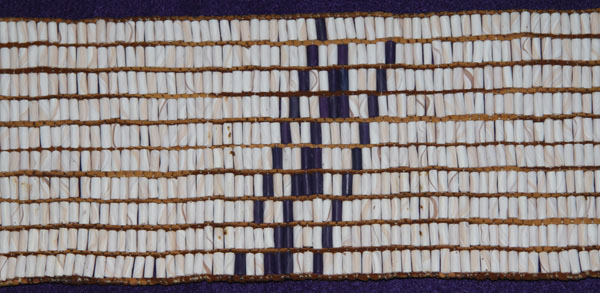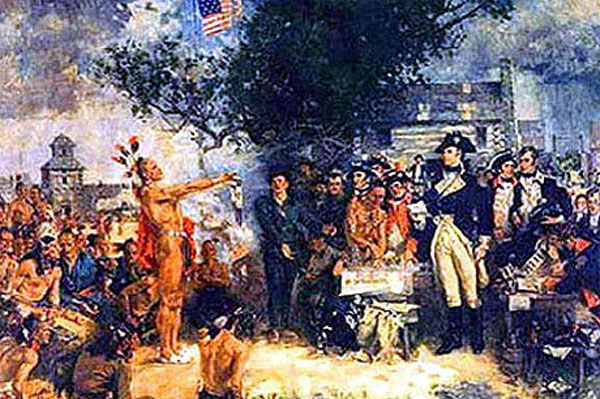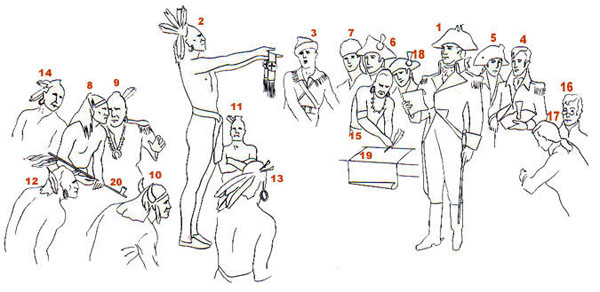 |
 |
Photographs (left to right): Luna Moth, Tioga, Pennsylvania; Mohave Desert; William Smith College, Adirondacks, New York
Wampum Belt Archive
Treaty of Greenville - 1795

Collection Ohio State No. H 50297


Reconstruction of the complete belt (R. D. Hamell: April 22, 2017)

Reproduction R. D. Hamell August 6, 2014


Howard Christy's painting of the "Signing of the Treaty of Green Ville" showing Blue Jacket in the Blue Officer's coat seated with Tarhe. |
Key to Painting "Signing the Treaty of Greene Ville" |
Full size reproduction: beaded length: 63 inches. 85 inches with fringe. 380 rows by 10.
Original Size: |
Length: 29.0 inches: Width: ~3.0 inches. Rows: 10. |
Reproduction: |
Beaded length: 37.5 inches by 4.5 inches. With fringe 61.5 inches. |
Beads: |
Beaded length: 246 columns by 10 wide: 2,460 beads |
Materials: |
Warp: leather. Weft: artificial sinew |
The Treaty of Greenville
"See again the smoke is curling
From the friendly calumet
And the Club of War is buried
And the star of slaughter is set."
-Anonymous
Description:
(Information from: U.S.-History.com)
The immediate threat of warfare between the white settlers and the native inhabitants of the Ohio Country had been reduced by Anthony Wayne’s victory at the Battle of Fallen Timbers in August 1794. A year later, the former contending forces gathered at Greenville (today in western Ohio) to sign a peace agreement. Wayne represented the federal government and expressed his hope that the treaty would last “as long as the woods grow and the waters run.”
The natives were less enthusiastic, regarding the agreement as a forced treaty. They had little choice because of the whites’ advantages in arms and numbers. Tribes represented included the Miami, Chippewa, Wyandot, Shawnee, Potawatomi, Kickapoo, Delaware, Wea, Piankashaw, Kaskaskia and Eel River.
Terms of the Treaty of Greenville included:
The tribes agreed to surrender their claims to lands in the southeastern portion of the Northwest Territory (mostly present-day southern and eastern Ohio).
The tribes also gave up additional defined areas that were used by the whites as portages and fort locations. This category included Fort Detroit and the site of the future town of Chicago on Lake Michigan
The United States government agreed to make an immediate payment of to $20,000 in goods to the tribes, as well as annual payments of $9,500 in goods to be divided among specified tribes.
The tribes retained the right to hunt throughout the area.
The Native Americans scrupulously abided by the terms of the treaty; American settlers did not. New white settlements outside of the treaty area were established almost immediately. Resistance would emerge in the early years of the next century in lands slightly farther west under the auspices of Tecumseh and his brother, The Prophet.
Hal Sherman stated: The TimeLine Magazine from the Ohio Historical Society had a photo of a belt that was giving to General Anthony Wayne at the negotiations. The design may represent the Three Fires of the Ojibwa, Ottawa, and Potawatomi.
From Fort Meigs Museum
GREENVILLE TREATY WAMPUM BELT OHC Artifact ID#: H50297 Date of Origin: 1795 Composition: Buckskin belt adorned with ten rows of white and black wampum arranged in a diagonal stripe pattern. Significance: This is a wampum belt given by Miami Chief Little Turtle to United States General Anthony Wayne on the occasion of the Treaty of Greenville. Wampum is made from a shellfish found only in the North Atlantic. It was used to adorn items of religious or political importance. The patterns formed by the shells can even encode messages. Wampum belts were often sent by couriers as a message of war or peace among the tribes. They were often exchanged at treaty negotiations to solemnize the agreements. The Treaty of Greenville established a firm border for the future State of Ohio, while preserving a corner of the state for Indian use. It ended a period of warfare that had lasted for ten years and laid the foundation for white settlement in the Midwestern states. General Wayne died in 1796 at Erie, Pennsylvania. Little Turtle passed away near Fort Wayne Indiana, only four days before the War of 1812 was declared.
Daniel Harrison:
The Greenville belt was cut in half, possibly by Wayne himself. The half that's in the Ohio Historical collection was acquired from his descendants. The fringe at the cut end of the buckskin warp is very short, unlike the normal fringe at the uncut end-- consistent with cutting in half. The other half of the belt has never surfaced. The fragmentary belt has 2 1/2 bands, each composed of 3 triangles and 2 diagonals. Ergo, the original would have had 15 triangles and 10 diagonals. There were 10 tribes represented at Greenville (not 12-- two tribes were added later), and both Wayne and Tarhe repeatedly referred to "the 15 fires of the United States." The 15 triangles thus symbolize the council fires of the 15 states. The ten diagonals use the same symbolism as the 6 diagonals commonly seen in Iroquoian treaty belts-- 6 braces, one for each of the Six Nations, holding up the Haudenosaunee longhouse. Here there are a total of 10 braces, for the 10 tribes of the Western Confederacy present at Greenville. Tarhe, who was undoubtedly the presenter of the belt, was acknowledging, through his words and the belt, that "we are now all children of the Fifteen Fires," and that the tribes of the Western Confederacy literally supported their ally, the United States. Source: Harrison, Daniel F. "Change amid Continuity, Innovation within Tradition: Wampum Diplomacy at the Treaty of Greenville, 1795." Ethnohistory, v. 64, no. 2, pp. 191-215.
Stolle, Nickolaus (2016): Ohio State purchased from Scott and Pamela Guthman.
Reference:
Courtesy of the Ohio Historical Society. http://www.shawnee-bluejacket.com/Gallery.htm
Fort Meigs Museum. http://www.fortmeigs.org/museum/
Harrison, Daniel. 2017. Personal Communications.
U.S.-History.com. Treaty of Greenville. http://www.u-s-history.com/pages/h1016.html
 |
 |
 |
 |
 |
 |
 |
 |
|---|